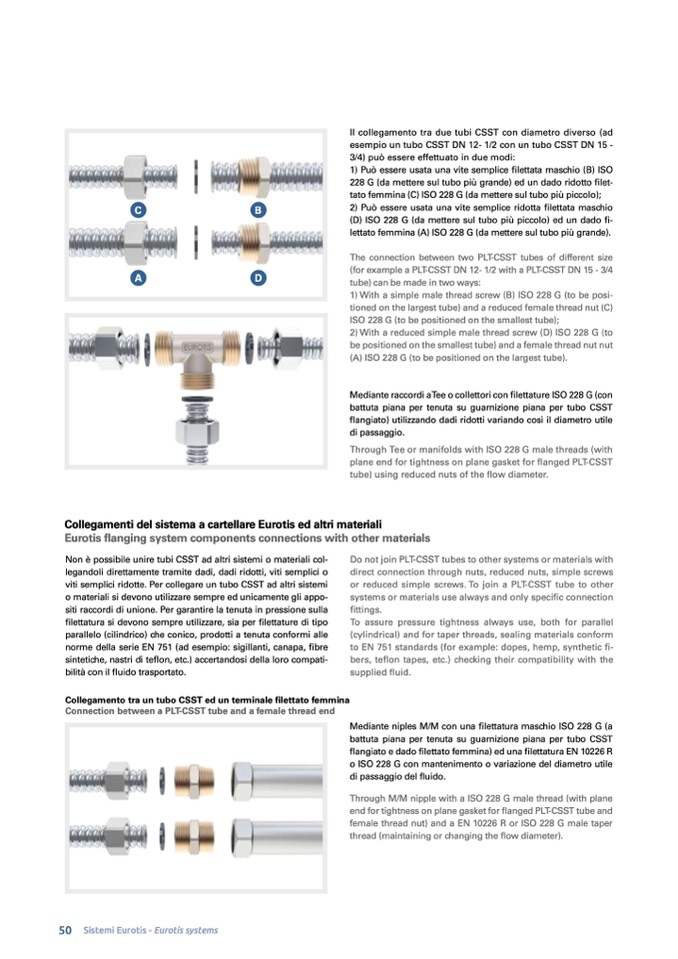
Il collegamento tra due tubi CSST con diametro diverso (ad
esempio un tubo CSST DN 12- 1/2 con un tubo CSST DN 15 -
3/4) può essere effettuato in due modi:
1) Può essere usata una vite semplice filettata maschio (B) ISO
228 G (da mettere sul tubo più grande) ed un dado ridotto filet-
tato femmina (C) ISO 228 G (da mettere sul tubo più piccolo);
2) Può essere usata una vite semplice ridotta filettata maschio
(D) ISO 228 G (da mettere sul tubo più piccolo) ed un dado fi-
lettato femmina (A) ISO 228 G (da mettere sul tubo più grande).
The connection between two PLT-CSST tubes of different size
(for example a PLT-CSST DN 12- 1/2 with a PLT-CSST DN 15 - 3/4
tube) can be made in two ways:
1) With a simple male thread screw (B) ISO 228 G (to be posi-
tioned on the largest tube) and a reduced female thread nut (C)
ISO 228 G (to be positioned on the smallest tube);
2) With a reduced simple male thread screw (D) ISO 228 G (to
be positioned on the smallest tube) and a female thread nut nut
(A) ISO 228 G (to be positioned on the largest tube).
Mediante raccordi aTee o collettori con filettature ISO 228 G (con
battuta piana per tenuta su guarnizione piana per tubo CSST
flangiato) utilizzando dadi ridotti variando così il diametro utile
di passaggio.
Through Tee or manifolds with ISO 228 G male threads (with
plane end for tightness on plane gasket for flanged PLT-CSST
tube) using reduced nuts of the flow diameter.
Collegamenti del sistema a cartellare Eurotis ed altri materiali
Eurotis flanging system components connections with other materials
C
B
A
D
Non è possibile unire tubi CSST ad altri sistemi o materiali col-
legandoli direttamente tramite dadi, dadi ridotti, viti semplici o
viti semplici ridotte. Per collegare un tubo CSST ad altri sistemi
o materiali si devono utilizzare sempre ed unicamente gli appo-
siti raccordi di unione. Per garantire la tenuta in pressione sulla
filettatura si devono sempre utilizzare, sia per filettature di tipo
parallelo (cilindrico) che conico, prodotti a tenuta conformi alle
norme della serie EN 751 (ad esempio: sigillanti, canapa, fibre
sintetiche, nastri di teflon, etc.) accertandosi della loro compati-
bilità con il fluido trasportato.
Collegamento tra un tubo CSST ed un terminale filettato femmina
Connection between a PLT-CSST tube and a female thread end
Do not join PLT-CSST tubes to other systems or materials with
direct connection through nuts, reduced nuts, simple screws
or reduced simple screws. To join a PLT-CSST tube to other
systems or materials use always and only specific connection
fittings.
To assure pressure tightness always use, both for parallel
(cylindrical) and for taper threads, sealing materials conform
to EN 751 standards (for example: dopes, hemp, synthetic fi-
bers, teflon tapes, etc.) checking their compatibility with the
supplied fluid.
50 Sistemi Eurotis - Eurotis systems
Mediante niples M/M con una filettatura maschio ISO 228 G (a
battuta piana per tenuta su guarnizione piana per tubo CSST
flangiato e dado filettato femmina) ed una filettatura EN 10226 R
o ISO 228 G con mantenimento o variazione del diametro utile
di passaggio del fluido.
Through M/M nipple with a ISO 228 G male thread (with plane
end for tightness on plane gasket for flanged PLT-CSST tube and
female thread nut) and a EN 10226 R or ISO 228 G male taper
thread (maintaining or changing the flow diameter).

